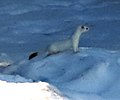| Subspecies | Trinomial authority | Description | Range | Synonyms |
|---|
| Junean stoat M. r. alascensis. | Merriam, 1896 | Similar to M. r. richardsonii, but with a broader skull and more extensive white tips on the limbs [9] | Juneau, Alaska | |
| Vancouver Island stoat M. r. anguinae | Hall, 1932 | | Vancouver Island | |
| Western Great Lakes stoat M. r. bangsi | Hall, 1945 | | The region west of the Great Lakes | cicognani (Mearns, 1891) pusillus (Aughey, 1880) |
| Bonaparte's stoat M. r. cigognanii  | Bonaparte, 1838 | A small subspecies with a dark brown summer coat; its skull is more lightly built than that of richardsonii. [10] | The region north and east of the Great Lakes | pusilla (DeKay, 1842) vulgaris (Griffith, 1827) |
| M. r. fallenda | Hall, 1945 | | | |
| M. r. gulosa | Hall, 1945 | | | |
| M. r. initis | Hall, 1945 | | | |
| M. r. invicta | Hall, 1945 | | | |
| Southwestern stoat or New Mexico ermine M. r. muricus | Bangs, 1899 | The smallest subspecies of richardsonii. [2] | The southwestern extremity of the species' American range (Nevada, Utah, Colorado and other states) | leptus (Merriam, 1903) |
| Olympic stoat M. r. olympica | Hall, 1945 | | The Olympic Peninsula, Washington | |
| Richardson's stoat M. r. richardsonii | Bonaparte, 1838 | Similar to M. r. cigognanii, but larger, with a dull chocolate brown summer coat [10] | Newfoundland, Labrador and nearly all of Canada (save for the ranges of other American stoat subspecies) | imperii (Barrett-Hamilton, 1904) microtis (J. A. Allen, 1903) mortigena (Bangs, 1913) |
| Baffin Island stoat M. r. semplei | Sutton and Hamilton, 1932 | | Baffin Island and the adjacent parts of the mainland | labiata (Degerbøl, 1935) |
| M. r. stratori | Merriam, 1896 | | | |





